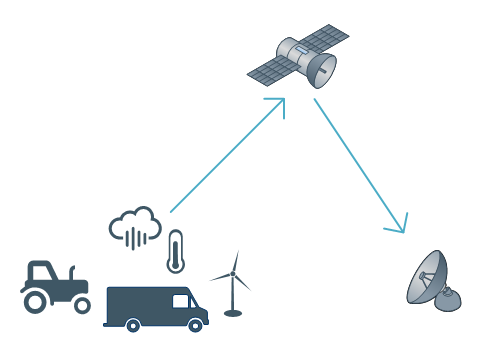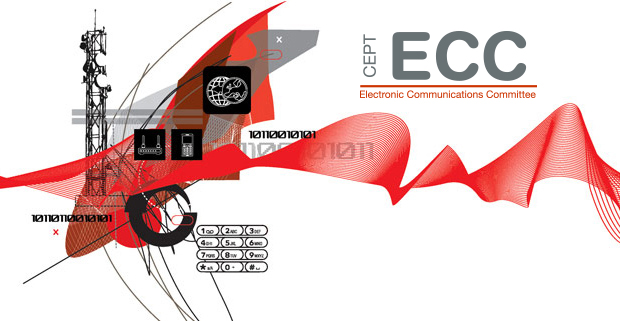ECC Newsletter September 2021
Satellite-based Internet of Things systems get a 21st century refresh
Operators who look for spectrum are facing opportunities and challenges in the existing ECC regulatory framework, writes Peter Faris and Jaime Afonso
The demand for spectrum for satellite-based Internet of Things (IoT) systems is on the rise. Recent technological developments have meant that smaller, cheaper satellites can now be deployed. As a result, there has been an increase in demand for spectrum from new players who want to deploy systems for a range of applications in sectors such as transport, energy and agriculture.
ECC Report 305, published in February 2020, provides further details on typical-use cases. Such applications tend to have low data-rate and low duty cycle requirements, for example, to transmit several kilobytes of data every few hours. This can be facilitated by a small constellation of satellites in low Earth orbit – a few hundred kilometres above the planet. They operate in narrow bandwidths in mobile-satellite service allocations available below 1 GHz.

Figure 1: Simplified schematic of typical satellite IoT applications
The increase in demand for spectrum for these types of satellite IoT systems has led to renewed interest in the ECC regulatory framework for Satellite Personal Communications Systems, or S-PCS.
Going back to the start
In the 1990s there was a surge in the use of mobile satellite service systems. The ITU and its member administrations recognised that such growth could be long-term, and that new, competing systems would emerge, so they made additional allocations of spectrum available. At the 1992 World Administrative Radio Conference and subsequent World Radiocommunication Conferences, it was decided that additional allocations of spectrum would be provided for mobile satellite service systems on a worldwide basis, and that they would be provided in frequency ranges below 3 GHz (see, for example, the outcome of the 1997 Conference).
CEPT undertook several initiatives to harmonise authorisation conditions and procedures. At that stage, it was considered that a coordinated approach was needed, given the vital importance for Europe's telecommunications and space industries.
The background and definition of the term S-PCS were described in detail in a 1995 CEPT ECTRA Report. The term "Little LEO", for example, was originally developed to distinguish mobile satellite service systems which operate below 1 GHz from "Big LEO" systems which operate above 1 GHz.
S-PCS operating below 1 GHz covers services such as low-bit-rate data communications, messaging, position determination and other non-voice applications for individual users, providing global coverage. These satellite systems are identified as “S-PCS below 1GHz” (S-PCS < 1 GHz), operating in the harmonised frequency bands 137-138 MHz (space-to-Earth) and 148-150.05 MHz (Earth-to-space), as well as 400.15-401 MHz (space-to-Earth) and 399.9-400.05 MHz (Earth-to-space).
In 1999, CEPT developed and published three CEPT Decisions for these bands:
- ERC Decision (99)06 on the harmonised introduction of satellite personal communication systems operating in the bands below 1 GHz (S-PCS< 1GHz);
- ERC Decision (99)05 on Free Circulation, Use and Exemption from Individual Licensing of Mobile Earth Stations (S-PCS < 1GHz)
- ECTRA Decision (99)02 on Harmonisation of authorisation conditions in the field of Satellite Personal Communications Services (S-PCS) in Europe, operating in the bands below 1 GHz (S-PCS < 1 GHz)
The harmonised conditions within this framework aim to ensure “maximum spectrum efficiency, maximum protection for terrestrial services as provided by the Radio Regulations and maximum competition” as set out in ERC Decision (99)06. This ERC Decision provides a procedure for the harmonised introduction of S-PCS within CEPT countries, including principles and criteria for the identification of spectrum to be used by the mobile earth stations, as well as technical and operational constraints for each system to be introduced.
ERC Report 087 was developed in 2000 to address sharing between S-PCS < 1 GHz and existing terrestrial services in the relevant bands allocated to mobile satellite systems below 1 GHz. The studies identified mitigation techniques to be employed by individual systems to improve the compatibility between mobile earth stations and other radio services. Based on this, operational constraints were specified for the candidate mobile satellite systems in accordance with the requirements of ERC Decision (99)06.
Accordingly, five systems were included in the original framework within the year 2000, of which only one – Orbcomm – remains in operation. The ECC Decisions then remained untouched for several years until recently.
The opportunities and the challenges
The opportunities provided by this framework, in particular the possibility for exemption from individual licensing across CEPT, have proven to be of interest to new operators planning to deploy satellite IoT systems in these bands. As a result, the ECC has received requests from five new operators since late 2018 – Hiber, Argos Kineis, Swarm, Myriota and Fleet Space. These requests have been presented and discussed within Project Team FM 44 (PT FM44).
The requests from new operators have raised a number of challenges in terms of how to use and interpret a framework developed and unchanged for the past 20 years, taking into account both advances in technology as well changes in policy and procedures within the ECC.
According to ERC Decision (99)06, new candidate systems can be added to the list of systems to be considered for introduction in CEPT countries when all necessary inter-service and intra-service compatibility studies have been successfully completed and agreed. Any required operational constraints based on the results of studies would also be added to the Decision.
Such studies have been underway within Project Team SE 40 since 2019 and results have been included in draft ECC Report 322.
The intra-service issues have proven to be one of the most challenging aspect in the studies, particularly as the number of new systems introduces a level of complexity that can slow down the overall review of the Decision. In other words, each combination of new candidate systems within the same band, as well as the existing Orbcomm system (in the case of the lower band), needs to be considered.
It should be noted that the intra-service compatibility studies are not intended to replace the ITU coordination process. Coordination principles under Article 9 of the Radio Regulations such as satellite network priority are excluded from consideration in these studies.
It is also worth noting that the requirement for such detailed intra-service studies is unique to this specific framework; other ECC Decisions on harmonisation of satellite bands do not contain similar requirements.
Simplifying and speeding up the process
These issues have been discussed in ECC and various sub-groups since 2019. Recognising the challenges, ECC agreed that a wider review of the framework would be beneficial in order to simplify the process for candidate operators, as well as the ECC groups addressing these issues.
However, as such a review would itself take some time, it was decided that this should not be at the expense of the operators who had already submitted requests for inclusion under the framework and were awaiting the outcome of studies. It was also agreed that individual updates of ERC Decision (99)06 could be published once the necessary studies were completed and agreed for each candidate system, without needing to await results for other operators who applied later in the process.
Consequently, three revisions of the Decision have been published since November 2020 – most recently in March 2021 – providing results for the Hiber, Argos Kineis and Swarm systems respectively. The corresponding studies have been included in draft ECC Report 322, which is intended for final publication once conclusions have been agreed for all new candidate systems.
Taking the next steps
Sharing studies remain ongoing, in particular to address two candidate systems, Myriota and Fleet Space. It is expected these studies could be completed by the end of the year.
Discussions have been initiated in PT FM44 on the wider review, which aims to merge the three existing Decisions into one. It will also aim to simplify and “future-proof” the overall process for any future candidate systems while ensuring sufficient protection for existing operators and for systems operating in adjacent bands. A draft work item is planned to be agreed by the end of the year, which will define in detail the scope and timeline for this activity.



